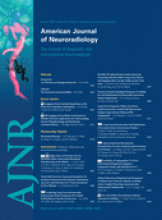Abstract
BACKGROUND AND PURPOSE: There is a high incidence of intracranial aneurysms of the AcomA suggesting the possibility of an anatomic risk factor. There also exists an association of termination-type aneurysms with anatomic variations of 1 anterior cerebral artery trunk (A1) as the exclusive or dominant supply to both pericallosal arteries (A2). This yields the hypotheses of aneurysm formation from straight jets of A1 blood.
MATERIALS AND METHODS: The anatomy and contrast filling of A1 and A2 segments and AcomAs were studied for a subset of cases entered into the Cerecyte Coil Trial for patients with AcomA (n = 105) and other aneurysms (n = 123) that were selected from imaging available at the Cerecyte Core Trial angiographic Core Lab. These cases were analyzed for A1 vessel dominance by measurement of the vessel diameter and dilution of angiographic contrast agent in A2s due to the differential flow source on selective angiography. A control group without aneurysms was assessed anatomically, using a large sequential CTA series (n = 159), acquired during acute stroke assessment.
RESULTS: A1 dominance configuration is strongly associated with the presence of AcomA aneurysms for patients with intracranial aneurysms (odds ratio, 17.8). This association is also present compared with the incidence of A1 dominance in the large sequential control series of patients without aneurysms undergoing CTA for other reasons (odds ratio, 7.5). Outflow dilution of selective angiographic images augments anatomic information.
CONCLUSIONS: A flow-based assessment of contrast flowing from the A1 to the A2 segments after injection pressure is superior to an A1 diameter based categorization when A1 vessel diameters are not strikingly different. The anatomic variant of asymmetric A1 configurations likely facilitates the development of AcomA aneurysms by flow stresses, providing further evidence to support the role of biophysical factors in intracranial aneurysm development.
Abbreviations
- AcomA
- anterior communicating artery
- A1
- anterior cerebral artery trunk
- A2
- pericallosal artery
- CI
- confidence interval
- CTA
- CT angiography
- DSA
- digital subtraction angiography
- ICA
- internal carotid artery
- MRA
- MR angiography
- Copyright © American Society of Neuroradiology












